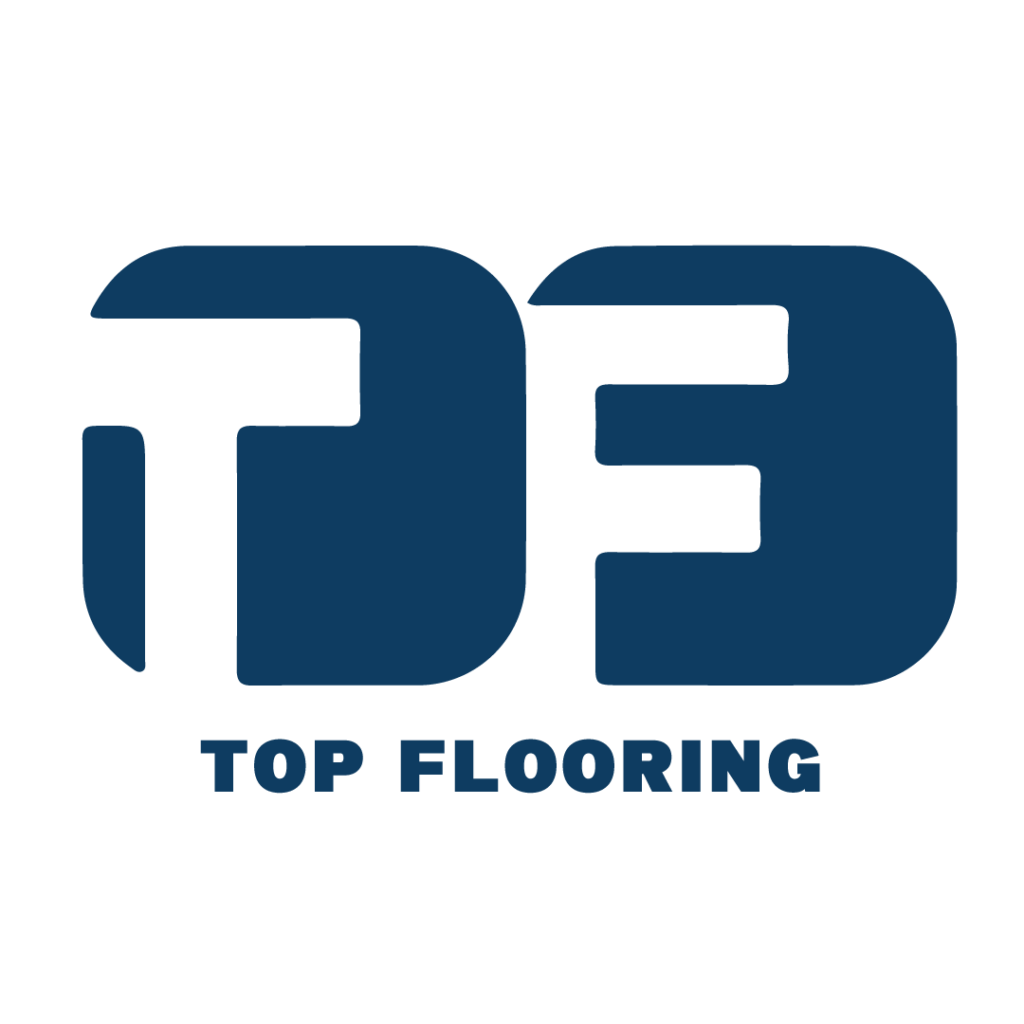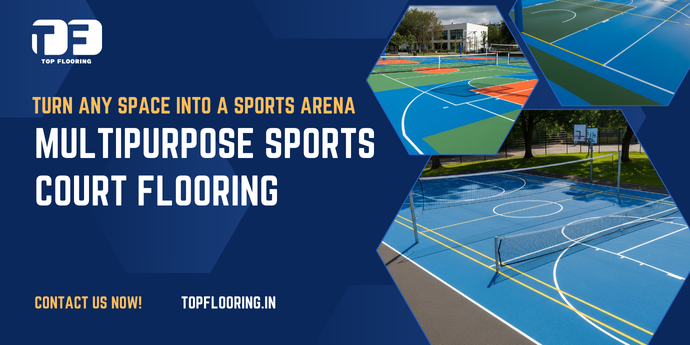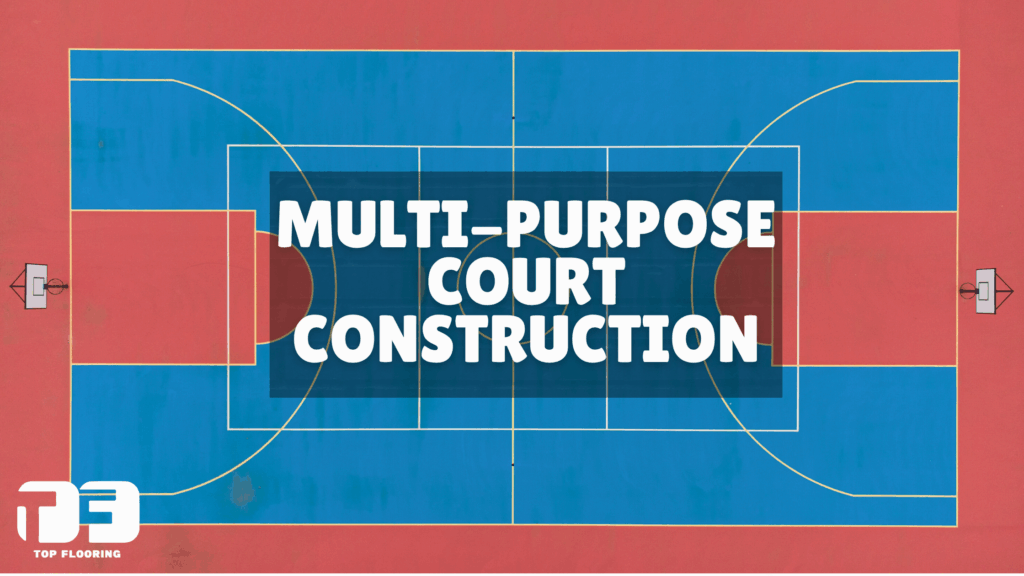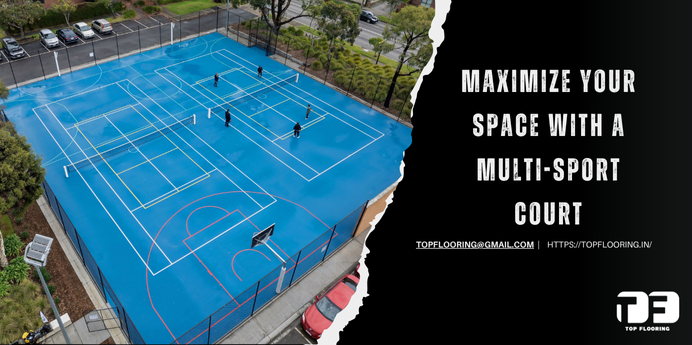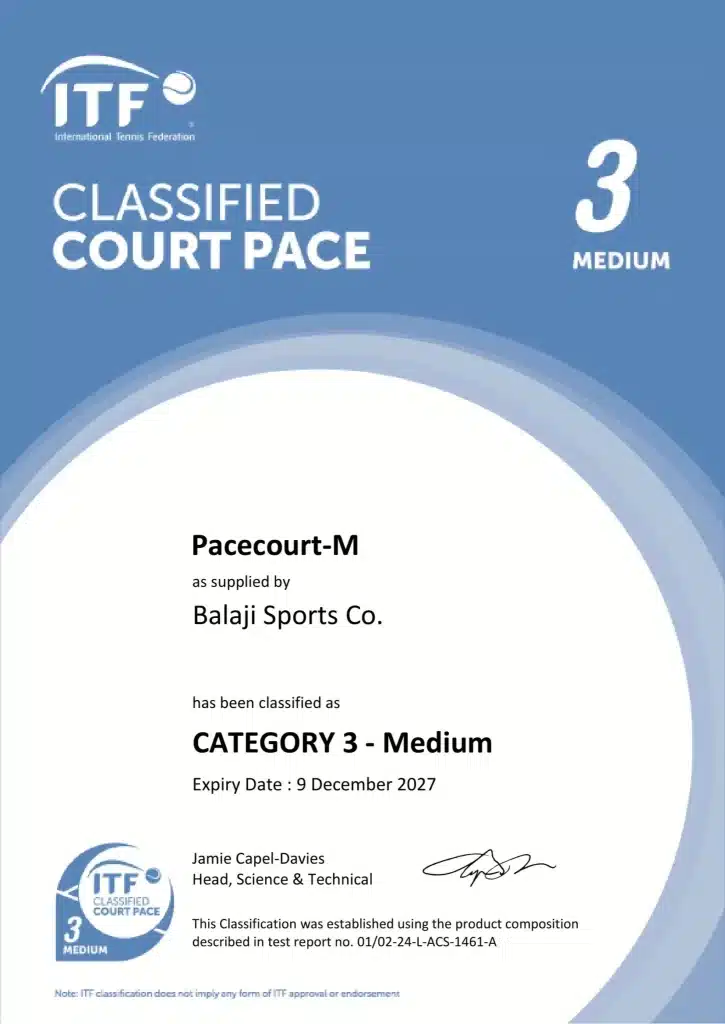Tired of choosing between a basketball hoop and a tennis net for your backyard? What if you didn’t have to pick just one? Imagine transforming a single space into a vibrant sports arena where friends shoot hoops in the morning, kids play badminton in the afternoon, and you serve aces on the tennis lines by evening all without leaving your property. That’s exactly what a multi purpose sports court makes possible. It’s a single, smartly designed sports court surface that supports multiple games like basketball, tennis, volleyball, badminton, and pickleball by offering unmatched versatility and space efficiency. Whether it’s for a residential complex, school, club or private villa, these sports courts turn limited space into all-season sports hubs.
In this article we’ll cover everything you need to know about building a multi purpose sports court flooring from choosing the right surface and popular layouts, to long term benefits and why it’s one of the smartest investments you can make for your home or community.
What Is a Multi Purpose Sports Court?
A multi purpose outdoor sports court is a specially designed surface that accommodates multiple sports on the same platform. Instead of building individual courts for each game, a multipurpose court combines markings and specifications of various sports like basketball, tennis, volleyball, badminton, and pickleball within one layout.
These courts are engineered for versatility, strength and safety. The lines for each sport are painted in different colors to avoid confusion. Players can switch between sports without changing venues. Which makes it ideal for schools, recreational centers and community parks.
Unlike single sport courts, multipurpose outdoor courts are built with extra resilience to handle different types of footwear, ball impact and player movement patterns. This makes them a cost efficient, high utility investment.
Types of Multi Purpose Courts
A multi purpose sports court isn’t a one size fits all structure. Depending on where it’s built and who uses it. These courts can be designed in different ways from full scale outdoor arenas to compact backyard play zones. Each type offers its own benefits in terms of durability, experience and cost. Let’s explore the three most common formats.
Multi Purpose Outdoor Sports Courts
Multi purpose outdoor courts are the most popular for schools, sports clubs and housing societies that see high footfall. These courts are designed to withstand activity from players of all age groups while providing a safe, uniform and vibrant surface for multiple sports. They allow institutions to host basketball, tennis, volleyball and badminton matches all on the same surface without needing separate spaces for each.
What sets them apart is their ability to withstand India’s unpredictable weather. Built with UV stable acrylic coatings, anti-slip textures and robust base systems. They don’t fade, crack or become slippery even in scorching summer heat or monsoon rains. Top Flooring builds multi purpose outdoor sports courts that are low maintenance and game ready for a long time. So communities get the most out of their space and investment.
Multi Purpose Indoor Courts
Indoor multi purpose courts are the preferred choice for competitive sports academies and training centers. They are protected from environmental factors like rain, heat and dust which means athletes can train and compete without interruptions or surface related inconsistencies.
Investment in indoor courts is worthwhile in terms of performance and longevity. They offer better traction, safety and a professional atmosphere that face tournament conditions. Though costlier to build than outdoor courts, their minimal maintenance and consistent surface quality makes them ideal for high performance play. For organizations looking to deliver world class training facilities, an indoor multipurpose court is the answer.
Backyard Multi Purpose Courts
Backyard multi purpose courts are specially created for individuals or home owners. Instead of relying on public facilities or memberships. Families are now choosing to turn unused open space into vibrant courts where multiple sports can be played anytime. These compact courts allow kids and adults to play basketball, tennis, badminton just steps away from their doors.
Besides offering round the clock play, backyard courts increase a property’s appeal and create a healthy lifestyle hub within the home. With Top Flooring’s custom acrylic systems, even small plots can be converted into eye catching, tournament quality play zones that blend beautifully with the surrounding architecture making them a smart investment in both health and home value.
Popular Layouts and Dimensions Of Multipurpose Court
Designing a multi purpose sports court is as much about strategy as it is about space. The challenge lies in fitting multiple games onto one surface without them interfering with each other. The layout needs to be efficient, safe and visually clear so players can switch between sports seamlessly.
Whether it’s for large institutions or compact residential plots, here are some of the most popular layout combinations used across India:
Multi Purpose Basketball Court & Volleyball Layout
One of the most common and space efficient designs combines a full basketball court flooring with a volleyball setup.
- Standard basketball court dimensions: 28 m × 15 m (91.9 × 49.2 ft)
- Volleyball markings are painted within the basketball area using a distinct line color for quick recognition.
This works perfectly for schools and sports clubs where both sports are played frequently. It allows seamless switching between matches, saving space without compromising on gameplay quality or safety.
Multi Purpose Tennis Court & Badminton Setup
Another option is to combine a tennis court with badminton lines for recreational or community use.
- Standard tennis court size: 23.77 m × 10.97 m (78 × 36 ft).
- Badminton lines are marked horizontally across the tennis court flooring using lighter or dotted lines to minimize visual clutter.
This works for multipurpose outdoor courts where both sports are played casually and not at a professional level, giving players more options without needing multiple courts.
Compact Backyard Multi Purpose Court
For homes, villas or farmhouses, a compact backyard multi purpose court is the answer.
- Typical custom sizes start from 10 m × 6 m depending on space available.
- These courts can have basketball half courts, tennis, pickleball, futsal and badminton markings on one surface.
Backyard courts allow families to play multiple sports without leaving their property and can be fully customized in terms of colors, logos and accessories.
Choosing the Right Multi Purpose Court Surface
The most important decision is choosing the right multi purpose court surface. Since multiple sports are played on it, the surface must have good grip, shock absorption and weather resistance.
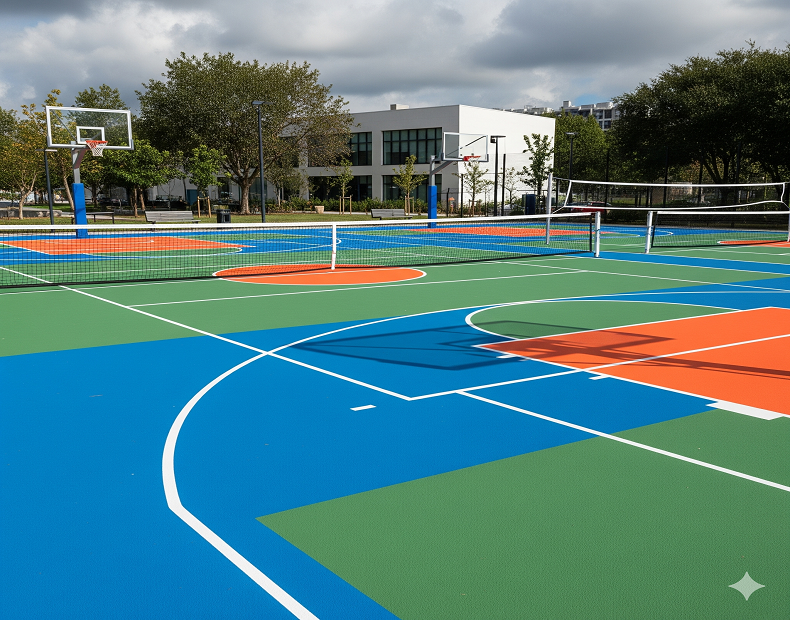
Acrylic Coating Systems
Acrylic flooring is the most popular choice for outdoor multipurpose courts. These coatings give a textured, non-slip finish that provides excellent traction even during intense play or light rain. They also give consistent ball bounce, strong UV resistance and vibrant, long lasting colors that stay bright in India’s harsh sun.
Another big advantage is the maintenance. Acrylic courts are easy to clean, quick to repair and can be installed over concrete or asphalt bases. Which makes them one of the most cost effective surfaces available. That’s why most schools, clubs and housing societies prefer them for multi game setups.
Cushioned Acrylic Systems
For sports courts that see a lot of high impact play like multi purpose basketball courts or multi purpose tennis courts. A cushioned acrylic system is a good upgrade. These systems have elastic cushion layers beneath the acrylic coats which add shock absorption and reduce the impact on joints during jumps, landings and sprints.
This design helps prevent injuries, reduces player fatigue and provides a more comfortable playing experience overall. Slightly more expensive than standard acrylic, they are ideal for facilities that focus on athlete safety and performance.
Modular PP Tiles
Polypropylene (PP) interlocking tiles are another surface option, known for their quick installation and portability. They can be assembled and disassembled easily, making them suitable for temporary or indoor multipurpose courts. However, they have limitations: PP tiles tend to get hot under the sun and require a perfectly levelled base to avoid surface instability. Not recommended for permanent outdoor setups where long term durability is critical.
At Top Flooring, the preferred choice for multi purpose court surfaces is high performance acrylic systems. They offer the best balance of cost, durability and multi-sport performance making them ideal for schools, academies, clubs and housing projects looking for long term reliability with low maintenance.
Multipurpose Court Construction Process and Cost Factors
Building a multi purpose sports court is a process that combines precision engineering with quality materials. Every stage — from ground preparation to final line markings — affects the court’s durability, safety and cost. Understanding how these stages come together helps planners make informed decisions and set realistic budgets for their projects.
Site Preparation
The first step is to prepare the site to ensure a solid foundation. This involves land leveling and grading to make a flat surface, followed by drainage planning for outdoor installations. Proper slope design ensures rainwater flows off the surface quickly, no puddles, erosion or long term water damage. A well prepared site is crucial to extend the life of the court.
Base Construction
Once the ground is ready, a strong base is laid using concrete or asphalt slabs. This base is the backbone of the court, everything above it rests on this. It’s essential to allow proper curing so the base becomes fully stable and doesn’t crack over time. Any weakness in this layer can lead to surface failures, that’s why expert supervision is necessary during this stage.
Acrylic Layering
After the base cures, the acrylic surfacing system is applied in multiple layers. This includes – Concrete primer, acrylic resurfacer, cushion coats, color coats, and line marking. Anti-slip or anti-fungal additives can also be mixed for extra performance and safety. Each layer adds strength, texture and color while ensuring consistent bounce, grip and weather protection. Especially for multi purpose outdoor sports courts that get heavy daily usage.
Accessories & Add-ons
Once the surface is complete the court is finished with sports equipment like nets, posts, hoops or goal frames depending on the sport. Many projects also include fencing, lighting, benches, seating zones and storage areas to make the court fully functional and user friendly. These add-ons enhance usability and create a professional playing environment.
Cost of Multipurpose Court
Cost of multi purpose basketball court or multi purpose tennis court depending on materials, cushioning and accessories. Compact backyard multi purpose courts cost less as they are smaller in size while outdoor multipurpose courts with fencing, lighting and custom branding can increase the overall cost. Other major factors that affect the pricing are surface type, site conditions, land location and design complexity.
Working with experienced professionals like Top Flooring ensures accurate budgeting, timely execution and premium surface quality and you get the best value for your money.
Benefits of Top Flooring Multi Purpose Sports Courts
Multi purpose sports courts at Top Flooring is more than just space saving — it’s a long term investment that converts any area into a sports hotbed. Designed to play multiple games on one surface, it’s perfect for schools, clubs, residential complexes and academies. From community engagement to land utilization, these courts give you many benefits that go beyond the cost of construction.
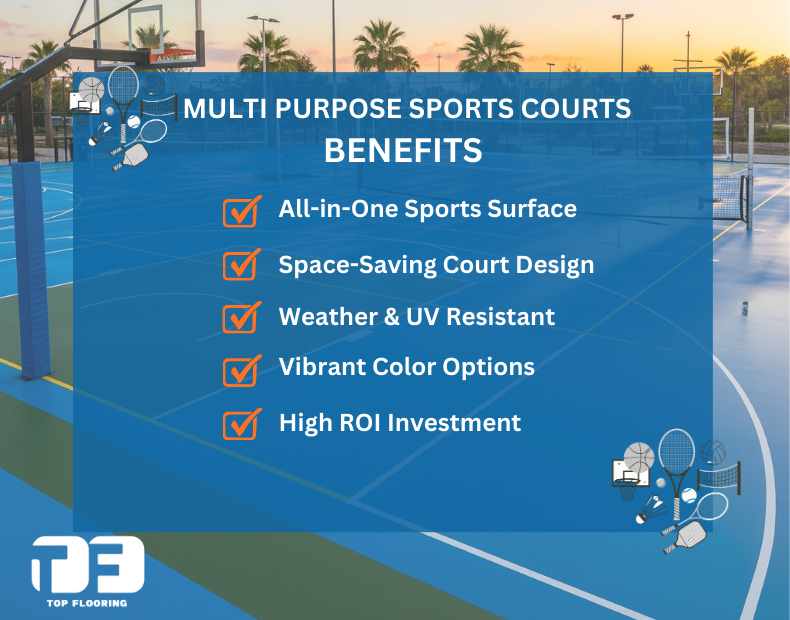
Maximize Space
One of the biggest advantages of multi purpose outdoor sports courts is that they can combine multiple sports into one layout. Instead of allocating separate land parcels for basketball, tennis, volleyball and badminton, a multipurpose court integrates all these games with distinct line markings. This way planners can make the most of the limited space and offer players multiple sporting options.
High ROI
Since one court serves multiple sports, the return on investment is higher. Schools, housing societies and sports clubs can offer multiple activities without multiplying the construction and maintenance costs. A well built multi-purpose sports court becomes a crowd puller that boosts participation and property value, making it a smart investment.
Encourages All-Age Engagement
These courts appeal to players of all ages and skill levels. Younger children can use the space for fun games, teenagers for competitive matches and adults for fitness oriented play. This all inclusive appeal creates a lively community atmosphere, encouraging regular physical activity and social interaction across generations.
Year Round Utility
Thanks to their durable construction and weather resistant acrylic surfaces, multi purpose outdoor sports courts can withstand intense sun, heavy monsoon rains and daily wear. This means year round usage with minimal downtime, so the court stays active and functional throughout all seasons.
Low Maintenance & Long Life
Acrylic based multipurpose surfaces known for low maintenance. They last 5-8 years before resurfacing and even routine cleaning is easy and cost effective. This long life reduces operational hassles and keeps the court safe, vibrant and performance ready for years.
Multipurpose Sports Court Maintenance and Long-Lasting Tips
Building a multi purpose sports court is just the first step — keeping it in top shape ensures players enjoy safe, high quality gameplay for years. Regular maintenance not only preserves the court’s appearance but also extends its life, protects your investment. With a few simple maintenance practices you can make sure your court performs like new season after season.
- Routine Cleaning: Dirt, leaves and debris can make the surface slippery and unsafe. Sweeping the court regularly and washing it occasionally with mild detergent prevents fungal or algae growth, especially during humid months. This basic care keeps the surface clean, grippy and visually appealing for daily play.
- Line Marking Touch-ups: Game lines can fade over time due to heavy foot traffic and sun exposure. Repainting them every 2-3 years keeps the lines sharp and clear so players can easily distinguish between sports boundaries. Proper line visibility is crucial for safe and organized gameplay on multi purpose outdoor sports courts.
- Seasonal Checks: Do seasonal checks to spot early signs of wear like small cracks, waterlogging or fading colors. This is especially important after monsoons as water damage can accelerate surface deterioration. Catch these issues early to avoid costly repairs later.
Top Flooring offers long term maintenance and resurfacing solutions to keep your multi purpose sports court tournament ready for years to come with minimal fuss.
Conclusion
A multi purpose sports court is more than just a play area — it’s a smart investment that combines functionality, durability and fun. Whether it’s an outdoor multipurpose court for schools, a multi purpose basketball court for clubs, or a multi purpose backyard court for private villas, this is the most you can get out of every square meter. Top Flooring designs advanced synthetic acrylic systems to perform across multiple sports. With expert design, tough materials and precise application your court can be a vibrant hub of activity for generations of players.
Frequently Asked Questions
A multi-purpose court is a single sports surface which support multiple games like basketball, tennis, volleyball, badminton, futsal, and pickleball. It combines different line markings on one durable acrylic surface, allowing flexible use of space without needing separate courts.
The minimum recommended size for a multipurpose court is around 10 metres × 6 metres for basic setups like half-court basketball, badminton, or pickleball. For full-size layouts that combine multiple sports, 28 meters × 15 meters is ideal to ensure safe play and proper run-off zones.
Yes, a tennis court can double as a basketball court by adding basketball hoop posts and color-coded court markings over the same surface. This space-saving layout is common in schools, clubs, and residential projects to increase versatility without expanding land use.
A multipurpose court can host various sports including basketball, tennis, volleyball, badminton, futsal, and pickleball. The surface is designed for multi-sport performance, with different colored lines marking each game’s layout for quick switching between matches.
Building a multipurpose court costs depending on surface type, size, and accessories. Factors like land preparation, fencing, lighting, and custom design also affect the total cost, especially for large outdoor multi-purpose courts.
The timeline can range from a few days to weeks, depending on the complexity of the project, site preparation required, and weather conditions.
